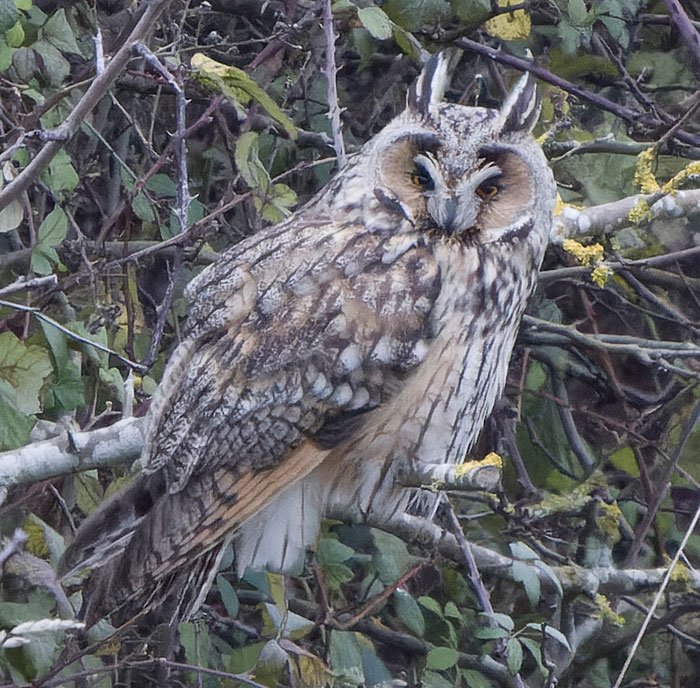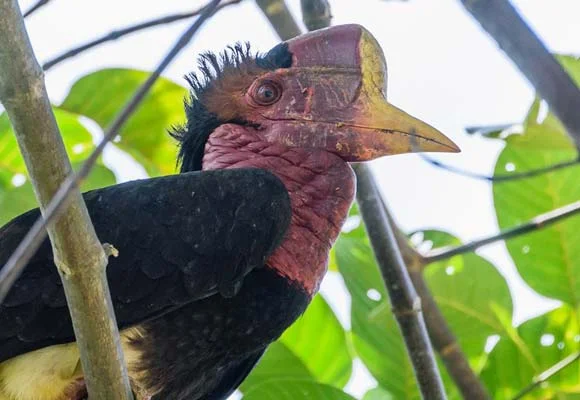Indonesia—Following its sensational rediscovery after 172 years, the mysterious Black-browed Babbler has finally documented in the wild for the first time. A team of ornithologists discovered, photographed, and obtained the first-ever footage of the rare babbler in its limestone habitat in Kotabaru Regency, South Kalimantan, Indonesia.
It is the first documentation of this species in its natural habitat following the picture of this bird on hand that circulated the internet after its rediscovery in 2020. This discovery has sparked global interest, given that the species has gone unobserved since colonial times.
The Black-browed Babbler was initially described by the renowned French naturalist, Charles Lucien Bonaparte in 1850, based on a single specimen collected by German geologist and naturalist Carl Anton Ludwig Maria Schwaner from his expeditions to southern Borneo around 1843-1848. This mysterious species, widely considered to be Borneo’s greatest ornithological enigma, was finally seen again in 2020 after being captured by a local resident. With a 172 years gap between its discovery and its first documentation in the wild, the species has indeed gone missing for a longer time than any other bird, including America’s presumed extinct Ivory-billed Woodpecker.
While the researchers were able to glean several clues about the species’ ecology, much of its life history is still shrouded by mystery. It is currently listed as “Data Deficient” by IUCN, with no information regarding its population or range. It is also not listed as a protected species by the Indonesian government due to the lack of data, which may make it vulnerable to threats such as poaching or habitat destruction.
In September 2021, a team of ornithologists from Birdpacker Indonesia collaborated with Kalimantan Selatan’s Natural Resource Conservation Agency (BKSDA Kalimantan Selatan) and Dinas Kehutanan Kalimantan Selatan KPH Cantung became the first team to explore the babbler’s habitat in an area of rugged limestone hills. The project was funded by Oriental Bird Club and American Bird Conservancy and was aimed to understand the status of the Black-browed Babbler’s population. On the first day of fieldwork, the team managed to re-find the bird and documented its natural behaviour for the first time in the wild.
According to Panji Gusti Akbar, the lead scientist from Birdpacker Indonesia, a pair of the birds were spotted in thick undergrowth on the side of a karst cliff just a few hours after they commenced their search. The birds were very secretive and moved quietly in extremely rugged terrain, making them difficult to observe—which may help explain why their evaded science for so long. After an intense wait, one individual of this strikingly marked babbler finally perched close enough for the team to capture the very first images and footage of the species in the wild.
“It was a breathtaking moment to finally see this species in the wild, as most of its natural history is entirely unknown—so that every single behaviour we observed can be new to science,” said Akbar.
Akbar also explains how Muhammad Suranto, a local community member and one of the original discoverers who also co-authored the paper documenting its rediscovery last year in 2020, greatly helped the expedition. The team went under his guidance during the entire expedition, and his expertise with the terrain along with some past encounters with the mysterious bird eventually led to the team’s success in re-finding the species.
“Suranto’s rediscovery in 2020 is like a Rosetta Stone in the ornithology community, a clue that eventually led us to the location of this enigmatic species and eventually kickstarted this expedition,” said Akbar. “All information he collected during the initial discovery helped us in designing this expedition, and without him who knows how many more years we have to wait until we can solve this century-long mystery about this bird’s whereabouts.”
The importance of this finding is noted by Paul Insua-Cao, Chair of the OBC Conservation Committee, who mentioned that this is a landmark project as global leaders meet to plan actions to address the biodiversity crisis. He also explained that this species’ extinction would have been inevitable without this discovery and that this project brings hope for other poorly known species.
“Significantly this work has been done by Indonesians reflecting a growing interest in this megadiverse country to understand and protect its unique natural heritage,” Paul said. “The OBC urges the relevant authorities to do what they can to protect the habitat of the black-browed babbler as soon as possible based on Birdpacker Indonesia’s work.”
Dr. Ir. Mahrus Aryadi, M.Sc, Head of the BKSDA South Kalimantan also noted the significance of this finding and give the highest appreciation to the team who have successfully found black-browed babbler in its native habitat. Mahrus noted that this is the first step towards the availability of valid and reliable data as a basis for future biodiversity management and that mapping location and human activities that might be a potential threat for the preservation of this species and the other wildlife are necessary things to get the point.
“Given that several encounters are outside the conservation area, it is important to collaborate with many parties regarding the protection of their habitat. BKSDA South Kalimantan will propose the area become Essential Ecosystem Area by collaborating with related stakeholders,” said Aryadi.
Just like other things in the world, the expedition has also been affected greatly by the COVID-19 global pandemic. Akbar said that the expedition was supposed to be commenced in June 2021, but the worsening condition of the pandemic delayed the project for over three months. However, after the condition is finally getting better some of the team made their way to Kalimantan and started fieldwork right away. The team will continue searching for more sightings of this babbler for another month to figure out its distribution and possible threat to its population, which will help determine the species’ threatened status and necessary action to conserve it.
Source:
Akbar, P.G., Nugroho, T.W., Suranto, M., Rizky Fauzan, M., Ferdiansyah, D.,Trisiyanto, J.S. & Yong, D.L. (2020) Missing for 170 years—the rediscovery of the Black-browed Babbler Malacocincla perspicillata on Borneo. BirdingAsia 34: 13–14.
BirdLife International (2001) Threatened birds of Asia: the BirdLife International Red Data Book. Cambridge, UK: BirdLife International.
BirdLife International (2020) Species factsheet: Malacocincla perspicillata. Downloaded from http://www.birdlife.org on 08/11/2020.
Collar, N.J. (2014) Blue-wattled Bulbul Pycnonotus nieuwenhuisii and Black-browed Babbler Malacocincla perspicillata: two Sundaic passerines in search of a life. BirdingASIA 21: 37–44.



































